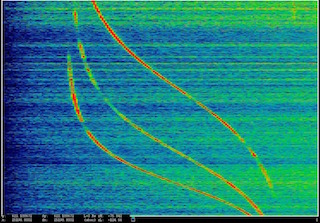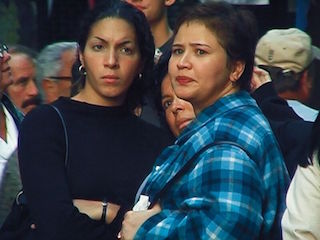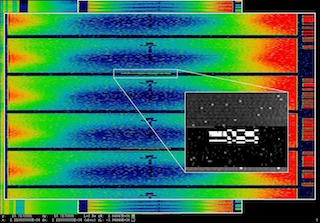Laura Poitras (b. 1964), ANARCHIST: Data Feed with Doppler Tracks from a Satellite (Intercepted May 27, 2009), 2016. Pigmented inkjet print mounted on aluminum, 45 x 64 3/4 in. (114.3 x 164.5 cm). Courtesy the artist
From movies to reality TV, Instagram to Facebook—it would seem most Americans are fairly obsessed with watching themselves and each other. At the same time, NSA leaks by Edward Snowden in 2013 reignited a national debate around personal privacy and how far is too far when it comes to government surveillance in the interest of “national security.” Laura Poitras’ new exhibit at The Whitney is particularly profound because the filmmaker and visual artist keys into a culture in conflict with itself, at once concerned with its personal privacy and pathologically voyeuristic. The timing is right too. With the Presidential campaign season in full swing and coming off of the heels of the 14th anniversary since the opening of Guantanamo Bay prison (another hallmark of the expansion of government powers post-9/11) Poitras insists that we reflect on our values as citizens and as human beings as we look to the future.
These themes are outgrowths of those explored in her “9/11 trilogy”: three feature-length documentaries centered on post 9/11 reactions and experiences. They include My Country My Country (2006), which follows the family of an Iraqi doctor during the US occupation, and The Oath (2010), which tells the story of two men whose meeting in 1996 leads them to Osama bin Laden, 9/11, and Guantanamo. The third and most famous film, CITIZENFOUR, won Best Documentary at the Academy Awards in 2015 and incidentally made Edward Snowden a movie star, forever influencing what it means to be a whistleblower (no different really than how the Academy sees any hero—white, male, etc.), and epitomizing the power of film to shift public discourse.
The show’s title actually comes from the name of the encrypted file Snowden sent to Poitras back in 2013, which led to the events detailed in CITIZENFOUR and a breech in the public’s trust on the scale of Watergate and Wikileaks. Snowden, however, is merely the jumping-off point. In ASTRONOISE the viewer is the protagonist. As such, geopolitical struggles and operations of mass surveillance exposed by Snowden and abstracted by CNN and FOX News, become deeply personal, placing the viewer at the center of a drama most have watched passively on TV.
You try to visualize it, you try not to. You are caught up in the suspense, the tragedy, the conflicted desire to look and to look away.
Foregrounded by the first of several video installations, ASTRNOISE is not about any religion, race, identity, gender or experience in particular. In O’Say Can You See, (2001/2016), a double video projection on a two-sided screen, the side facing the gallery’s entrance depicts New Yorkers of all colors, sizes, religious backgrounds and ages, peering from across the street at the remains of the felled Twin Towers in the days that followed the 9/11 attacks. The devastation remains off camera. Like any good movie, what you don’t see, and perhaps never saw except on TV and from thousands of miles away, preys on your imagination. You try to visualize it, you try not to. You are caught up in the suspense, the tragedy, the conflicted desire to look and to look away.
On the other side, another video depicts a man with a bag over his head at the mercy of armed soldiers; an image that, from Abu Ghraib to Guantanamo, has become emblematic of America’s post-9/11 “war on terror” and the governments succeeding expansion (and abuses of) power.
On camera, there is an attack-dog. A man in the corner in a uniform with a mask and a rifle. There are other figures just off camera. The viewer doesn’t’t know why the subject is being interrogated. It doesn’t really matter. What feels more urgent is what will happen if he repeats the answer, which clearly is not satisfying to his interlocutors, again. The threat of violence looms large, a typical scene of what we imagine torture to look like. But here, the viewer is compelled to be more than a voyeur—to become Salim Hamdan or Said Boujaadia, the two prisoners respectively seen in the military footage of interrogations that took place in Afghanistan after 9/11, both of whom were subsequently sent to Guantanamo Bay prison. There is no broadcast explaining what this means or what the viewer should believe this man did. The Oath details the trial of Hamadan, a former driver for Osama bin Laden, but none of that really matters either. Instead, what comes into sharp focus is the bald fear and exhaustion the unidentified man must be experiencing, your desire for him to speak the words that will set him free, and your foreboding that they do not exist.
The exhibit continues down an adjoining hall. Plunged in darkness, it’s hard to know what comes next. You must find your way, a central mandate of ASTORNOISE. As the viewer moves further the walls appear dotted with cell-block windows through which someone in solitary confinement or being indefinitely detained in Guantanamo Bay, might view the world. Light emanates from each, bathing the dark hall in white noise. Peering into each cell block, classified documents come into view, like hieroglyphic symbols or clues in a mystery.
Deposition Matrix (2016) reveals a trove of primary documents, interviews, and dialogues. One 2008 Department of Defense classified memo defines when a cyber-attack constitutes an act of war. Another chillingly explains that a covert action is one executed as to conceal the sponsor. Actions, for instance, like those investigated by Congress in 1975-76, that came to light after a break-in at Democratic National Committee headquarters. A historic leak that precedes Snowden and the NSA that revealed among other activities, the Central Intelligence Agency’s (CIA) efforts to subvert democratically elected foreign governments.
Through the picture-glass window, and in this context, these materials take on the aspect of artifacts, similar to those of over-reaching empires—from Egypt to Rome—which you might find at any museum. Reminding the viewer, too, that history has a tendency of repeating itself.
the viewer is put in a situation where the neighboring viewer is literally spying over one’s shoulder and vice a versa.
Perhaps more revealing are the subtle ironies and paranoias that permeate the staging of the exhibit. With scarcely more than one person at any given time able to peer through these portholes that reveal complicated systems of secrecy and surveillance, the viewer is put in a situation where the neighboring viewer is literally spying over one’s shoulder and vice a versa. Further, the physical deprivation—my back was killing me after five minutes of stooping to see, while other patrons strained on tip toe to do the same – forms a perfect proxy for how we experience systems designed to obscure, deny and limit access to information, all interests central to ASTRONOISE.
The third installation, Bed Down Location (2016) features a massive video installation suspended from the ceiling. It is a projection of the night skies over Yemen, Somalia, and Pakistan—countries where the US military conducts “targeted killings” using umanned aircrafts. Visitors are encouraged by an elevated step to lie down and look up at the night sky filled with stars like eyes, or the flashing bulbs of a million tiny cameras. It is, again, a perfect simulation of how we participate in systems of surveillance: because there is only so much room to lie down, viewers are thrust into the role of surveiller, watching each other as they watch the stars.
The final video in the exhibition confounds more than it yields. “In May 2004, I traveled to Baghdad to make a film about the US occupation of Iraq” the artist’s voice whispers through mounted speakers. The voice goes on to narrate a companion video Poitras recorded in May 2004, “On November 19th, US and Iraqi soldiers raided a mosque…at one point…I followed with my camera and filmed for eight minutes and sixteen seconds. These eight minutes changed my life, but I didn’t’t know it at the time”.
Her words are enigmatic as the video, in fact, reveals very little. Pointras shows an Iraqi family with whom she was staying while working on a film about the US occupation of Iraq. Several children comment on the gunfire and skirmishing. They intermittently tease one another as children do all over the world. The film shows a scuffle including a dearth field and several scattered soldiers. One of the family members shouts, “There it is, the plane!”
It seems to matter less what was captured of the skirmish, with the camerawoman focused instead on the humanity of this civilian family and what they made of the commotion. Like the earlier footage of interrogation, she insists the viewer imagine how the subjects of the film feel. The viewer is asked to make sense of the scene with the people in the footage, again shifting responsibility for interpreting what is being seen to the individual seeing it.
By taking the time to listen to the full audio recording (which is hard to hear in a room of people) and observing redacted government documents mounted on the wall, viewers learn that Poitras’ presence at the scene landed her on a government watchlist when she returned to the United States. And, only ten years later, after filing a lawsuit against the government, did she find out why.
Why indeed. When visitors exit the exhibit, they observe a monitor streaming cell-phone data like a Facebook feed on everyone who has passed through Bed Down Location. The exit suggests the answer yields as little as this information and its imprecise means of extraction.
If, as citizens, we value personal privacy, and expect transparency and accountability of our government, like any right, it is our responsibility to protect it.
With ASTRONOISE, Pointras emerges a Maverick displaying a deep and sophisticated understanding of the imitable relationship between the personal and the political, placing her audience in physically, emotionally, and psychologically uncomfortable positions. She offers a wakeup call: if, as citizens, we value personal privacy, and expect transparency and accountability of our government, like any right, it is our responsibility to protect it. It is seeking out information, not simply consuming it, and understanding that where those rights are violated, here or on foreign shores, it is an erosion of our collective claim upon them.
Poitras’ show also marks a shift for The Whitney, which seems to be getting more comfortable in its new digs, “shifting to something more experimental” as the program coordinator for ASTRONOISE put it. Pointras’ show will be followed shortly by an exhibit by another filmmaker. Late April or early May, Steve McQueen, Academy Award-winning director of “12 Years a Slave,” will be presenting his own video installation that will expand on his work End Credits, which presents FBI files kept on the African American performer Paul Robeson. Perhaps this marks a new wave of filmmakers breaking down the barrier between narrative filmmaking and contemporary art. More likely it is simply a recognition of the versatility required, inundated as we are by information and media, to break through the noise.




